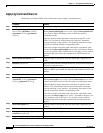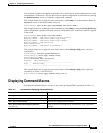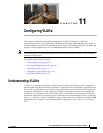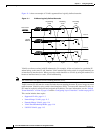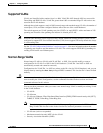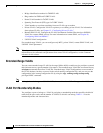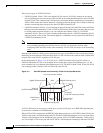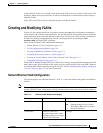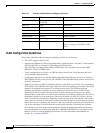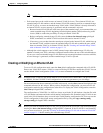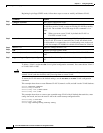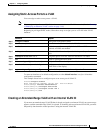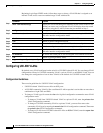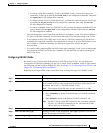
11-6
Cisco ME 3400 Ethernet Access Switch Software Configuration Guide
OL-9639-06
Chapter 11 Configuring VLANs
Understanding VLANs
There are two types of UNI-ENI VLANs:
• UNI-ENI isolated VLAN—This is the default VLAN state for all VLANs created on the switch.
Local switching does not occur among UNIs or ENIs on the switch that belong to the same UNI-ENI
isolated VLAN. This configuration is designed for cases when different customers are connected to
UNIs or ENIs on the same switch. However, switching is allowed among UNIs or ENIs on different
switches even though they belong to the same UNI-ENI isolated VLAN.
• UNI-ENI community VLAN—Local switching is allowed among UNIs and ENIs on the switch that
belong to the same community VLAN. If UNIs or ENIs belong to the same customer, and you want
to switch packets between the ports, you can configure the common VLAN as a UNI-ENI
community VLAN. There is no local switching between the ports in a UNI-ENI community VLAN
and ports outside of the VLAN. The switch supports a combination of only eight UNIs and ENIs in
a UNI-ENI community VLAN.
Note Local switching takes place between ENIs and UNIs in the same community VLAN. Because
you can enable spanning tree on ENIs, but not on UNIs, you should use caution when
configuring ENIs and UNIs in the same community VLAN. UNIs are always in the forwarding
state.
Network node interfaces (NNIs) are not affected by the type of UNI-ENI VLAN to which they belong.
Switching can occur between NNIs and other NNIs or UNIs or ENIs on the switch or other switches that
are part of the same VLAN, regardless of VLAN type.
In the configuration in Figure 11-2, if VLAN 10 is a UNI-ENI isolated VLAN and VLAN 20 is a
UNI-ENI community VLAN, local switching does not take place among Fast Ethernet ports 1-4, but
local switching can occur between Fast Ethernet ports 6-10. The NNIs in both VLAN 10 and VLAN 20
can exchange packets with the UNIs or ENIs in the same VLAN.
Figure 11-2 UNI -ENI Isolated and Community VLANs in the Cisco ME Switch
A UNI or ENI can be an access port, a trunk port, a private VLAN port, or an IEEE 802.1Q tunnel port.
It can also be a member of an EtherChannel.
When a UNI or ENI configured as an IEEE 802.1Q trunk port belongs to a UNI-ENI isolated VLAN, the
VLAN on the trunk is isolated from the same VLAN ID on a different trunk port or an access port. Other
VLANs on the trunk port can be of different types (private VLAN, UNI-ENI community VLAN, and so
on). For example, a UNI access port and one VLAN on a UNI trunk port can belong to the same UNI-ENI
To service-provider network
VLAN 10:
(
UNI-ENI isolated VLAN)
Fast Ethernet
ports 1 – 4
Fast Ethernet
ports 6 – 10
VLAN 20:
(UNI-ENI community VLAN
)
NNIs
UNIs or
ENIs
Customer-facing ports
Gigabit Ethernet port 1
Gigabit Ethernet port 1
Gigabit Ethernet port 2
Gigabit Ethernet port 2
Gigabit Ethernet port 1 Gigabit Ethernet port 2
92914



